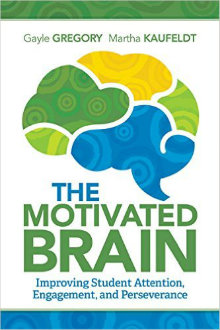Brain Research about Attention & Engagement
The Motivated Brain: Improving Student Attention, Engagement, and Perseverance
By Gayle Gregory and Martha Kaufeldt
(ASCD, 2015 – Learn more)

The Motivated Brain: Improving Student Attention, Engagement, and Perseverance by Gayle Gregory and Martha Kaufeldt provides educators a better understanding of the brain and offers suggestions for implementing strategies to improve attention, engagement, and perseverance.

In the brain’s emotional networks, Panksepp states, the SEEKING system deserves the greatest emphasis in education as it “plays a key role in learning and making connections.” (p.38)
What’s in the book
The Motivated Brain addresses ways teachers can stimulate the SEEKING system into action. Readers are reminded of the importance of building relationships and fostering collaboration in order for group work and learning to be successful. The authors suggest that practicing skills can and should be fun.
Preferred Activity Time (PAT) allows students to earn the privilege of having fun while learning. To encourage and facilitate active processing, the following strategies are suggested:
- discussing new learning experiences;
- making a connection to prior learning;
- discovering relevance to students’ daily lives;
- creating sustained anticipation and interest; and
- developing optimistic “growth” mindsets. (p.77)
Strategies for helping students make thinking visible include predicting outcomes, evaluating work, questioning by the teacher or a significant friend, and encouraging self-questioning. (p.102)
If you are interested in the research of motivation and engagement, The Motivated Brain is a good choice; there are 11 pages of references for 149 pages of text. However, if you are mostly searching for innovative strategies and practical applications to motivate students, this may not be your best choice.
__________________
Anne Anderson finally got out of the 8th grade after 24 years and 9 weeks. She spent the next 9 years sharing her expertise in literacy and writing with K-12 teachers and administrators throughout the district. She credits National Writing Project and Poetry Alive! as turning points in her growth as a teacher. She now shares her expertise nationwide as an educational consultant and through her website and her bi-monthly newsletter, Spotlight on Success.



































I write study skills and other curriculum (The Middle School Student’s Guide to Study Skills) and agree that these are very important strategies. I explain to students that taking some time to connect to prior learning before tackling something new is like stretching before a workout, and that these strategies really work to their advantage because they decrease the amount of time it takes to learn while increasing the amount of information retained.